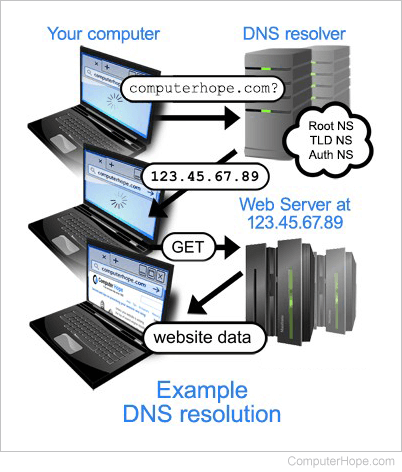DNS resolver
A DNS resolver, also known as a resolver, is a server on the Internet that converts domain names into IP addresses. Below is an example of your computer's communication with DNS (Domain Name System) to resolve a domain name into an IP address.

When you use the Internet, every time you connect to a website using its domain name (such as "computerhope.com"), your computer needs to know that website's IP address (a unique series of numbers). So your computer contacts a DNS resolver and gets the current IP address of computerhope.com.
Usually, the resolver is part of a larger decentralized DNS (domain name system). When you send your request to the DNS resolver, the resolver accesses other servers in the DNS to obtain the address, then sends you the response.
The DNS resolver your computer contacts is usually chosen by your ISP (Internet service provider). However, you can configure your network to use a different DNS provider. This configuration can be modified in your operating system's network settings or the administration interface of your home network router.
How to change your DNS resolver
Each network adapter on your computer (Ethernet and Wi-Fi, for example) can have its own DNS resolver setting. The default setting is "Obtain a DNS server automatically." With this setting, connections on that network adapter use the DNS server addresses configured in your home router.
To use another DNS, you must know the IP address(es) for that DNS.
For a list of alternative DNS providers, and instructions for how to use them, see: How to change a computer DNS address.
Why do you need a DNS resolver?
Every domain name on the Internet has one or more IP addresses. These addresses can change at any time, but the domain name never changes. The Domain Name System is an up-to-date index of those IP addresses. The DNS resolver is the outward-facing part of that system that receives your requests and sends you the resolution.
How names are resolved
When the DNS resolver receives your request, it queries the Domain Name System to determine the IP address. These queries may be "recursive," "non-recursive," "iterative," or a combination of these.
The following steps occur in a commonly-used recursive Domain Name System:
- The DNS resolver receives a domain name, then queries one of thirteen root nameservers.
- The root nameserver maintains an up-to-date index of TLD (top-level domain) nameservers, each of which handles a specific TLD, such as .com, .org, or .net. The root nameserver passes the query to a server that handles that TLD.
- The TLD nameserver maintains an up-to-date index of authoritative nameservers within that TLD. The query is forwarded to the server associated with that domain name.
- The authoritative nameserver's index contains the server address information, as kept on record by the domain name registrar, whose services are directly contracted by the domain name owner.
- This information is recursively returned to the DNS resolver, which responds to the requesting user with the resolved IP address.
Note that this complete sequence of queries is not necessarily performed every time a request is made. At each step, a server in the DNS may respond with its cached copy of the information. How often these caches expire and the information refreshed depends on the operator of the DNS.
If the DNS is recursive, as in this example, the DNS resolver may be called a recursor.
